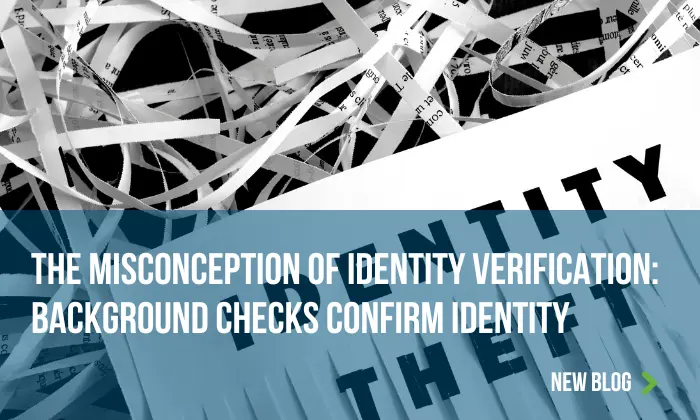In an increasingly digital world, where online interactions and transactions have become the norm, the need for robust identity verification has never been more crucial. Yet, there is a common misconception that background checks alone are sufficient to confirm someone’s identity. The truth is, that background checks play an important role in certain aspects of identity verification, but they fall short of providing a comprehensive verification process.
Identity theft is a serious crime that can have a devastating impact on victims. In the United States, the number of identity theft cases has been on the rise in recent years. In 2022, the Federal Trade Commission (FTC) received over 1.4 million reports of identity theft, a 19% increase from the previous year. The average financial loss per victim was $3,500.
The average victim of identity theft spends 200 hours and $1,700 to resolve the issue. Identity theft can lead to financial problems, such as difficulty getting loans or credit cards, and even bankruptcy. Identity theft can also damage your credit score, making it more difficult to get approved for loans or credit cards in the future.
Understanding Identity Verification
Identity verification is a fundamental process that involves confirming the authenticity and accuracy of an individual’s claimed identity. It serves as a crucial step in various contexts, including financial transactions, online registrations, employment screenings, and accessing sensitive information. The primary goal of identity verification is to establish trust and ensure that individuals are who they claim to be.
Identity verification methods can vary depending on the level of assurance required and the specific industry or application. Traditional methods, such as checking government-issued identification documents like passports or driver’s licenses, have long been used for verification purposes. However, with the rise of digital platforms and remote interactions, innovative and technologically advanced methods have emerged.
Today, identity verification leverages a combination of data, biometrics, and advanced technologies to establish and authenticate an individual’s identity. These methods can include:
Document Verification:
Verifying the authenticity of physical or digital identity documents, such as passports, national IDs, or driver’s licenses, by checking security features, holograms, or unique identifiers.
Biometric Verification:
Utilizing biometric data, such as fingerprints, facial recognition, or voice recognition, to confirm an individual’s unique biological characteristics.
Knowledge-Based Verification:
Authenticating an individual’s identity by asking specific questions related to personal information, such as past addresses, family members, or financial history, which only the legitimate individual should know.
Two-Factor Authentication (2FA):
Adding an additional layer of security by combining multiple verification factors, such as a password or PIN along with a verification code sent to a trusted device or email.
Third-Party Data Checks:
Utilizing data from external sources, such as credit bureaus, public records, or identity verification databases, to corroborate and validate an individual’s information.
Machine Learning and Artificial Intelligence:
Employing advanced algorithms and pattern recognition to analyze data, detect anomalies, and identify potential fraudulent activities or suspicious behavior.
It’s important to note that identity verification is not a one-size-fits-all process. The level of verification required may vary based on the specific circumstances and risk tolerance of different organizations or industries. While background checks are an essential component of identity verification, they only provide limited information about an individual’s past, such as criminal records or employment history. Therefore, relying solely on background checks falls short of ensuring a comprehensive verification process.
The Role of Background Checks
Background checks are an integral part of the identity verification process, providing valuable insights into an individual’s background and history. They are commonly used by organizations and employers to assess an individual’s suitability for employment, tenancy, or other engagements. While background checks serve a crucial purpose, it is essential to understand their role and limitations in confirming someone’s identity.
Background checks typically involve gathering information from various sources to evaluate an individual’s past activities and behavior. Some of the key components often included in background checks are:
Criminal Records:
Background checks may involve checking local, state, and federal criminal databases to identify any past convictions or involvement in criminal activities.
Employment History:
Verifying an individual’s work experience, including past employers, positions held, and dates of employment. This helps employers assess an applicant’s qualifications and reliability.
Education Verification:
Confirming an individual’s educational qualifications, such as degrees, certifications, or diplomas, by contacting educational institutions or using third-party verification services.
Reference Checks:
Contacting provided references to gain insights into an individual’s character, work ethic, and suitability for the position or engagement in question.
Credit History:
Assessing an individual’s financial history and creditworthiness by reviewing credit reports, payment history, and debt obligations. This is particularly relevant for roles involving financial responsibilities.
Background checks can provide valuable information for risk assessment and making informed decisions. They help organizations ensure the safety and integrity of their workforce and protect against potential liabilities. However, it is crucial to recognize that background checks have certain limitations in confirming an individual’s identity.
Background checks primarily focus on verifying an individual’s past activities and qualifications, such as criminal records or employment history. While these components provide important insights, they do not directly confirm an individual’s identity. Background checks are limited to the information available in public records and the accuracy of the provided information.
Limitations of Background Checks in Confirming Identity
While background checks are a valuable tool in assessing an individual’s past activities and qualifications, it’s important to understand their limitations when it comes to confirming someone’s identity. Background checks have specific boundaries and should not be solely relied upon for comprehensive identity verification. Here are some key limitations to consider:
Limited Scope:
Background checks typically focus on specific aspects of an individual’s background, such as criminal records, employment history, or education. They may not capture the entirety of an individual’s identity or provide a complete picture of their qualifications, character, or personal attributes.
Identity Discrepancies:
Background checks rely on the accuracy and consistency of the information provided by the individual. If there are discrepancies or inaccuracies in the provided information, the background check results may not accurately reflect the person’s true identity.
Incomplete Records:
Background checks rely on publicly available records and databases, which may not always be comprehensive or up-to-date. Information gaps or omissions in the records can hinder the ability to confirm an individual’s identity conclusively.
Identity Theft:
Background checks may not detect instances of identity theft or fraudulent activities where someone assumes another person’s identity. If an individual’s identity has been compromised, background checks alone may not uncover this deception.
Lack of International Coverage:
Background checks are typically limited to the jurisdiction where the search is conducted. Conducting comprehensive international background checks can be challenging due to varying legal systems, language barriers, and differences in record-keeping practices.
False Sense of Security:
Relying solely on background checks for identity verification can create a false sense of security. Criminal records and employment history, while important, do not guarantee an individual’s true identity or their suitability for a particular role or engagement.
To overcome these limitations and ensure a more robust identity verification process, organizations should consider incorporating additional methods and technologies. Supplementing background checks with techniques such as document verification, biometric authentication, or knowledge-based verification can enhance the accuracy and reliability of confirming someone’s identity.
Comprehensive Identity Verification Processes
To establish robust and reliable identity verification, organizations should adopt comprehensive processes that go beyond relying solely on background checks. By integrating multiple methods and technologies, organizations can enhance the accuracy, security, and confidence in confirming someone’s identity. Here are key components of a comprehensive identity verification process:
Document Verification:
Utilize advanced document verification techniques to authenticate the validity of physical or digital identity documents. This includes checking security features, holograms, watermarks, or utilizing document verification software to detect tampering or forgery attempts.
Biometric Verification:
Incorporate biometric authentication methods such as fingerprint scanning, facial recognition, or voice recognition to confirm an individual’s unique biological characteristics. Biometric verification adds an additional layer of certainty as these features are difficult to replicate or forge.
Knowledge-Based Verification:
Implement knowledge-based verification by asking specific questions related to personal information that only the legitimate individual should know. This can include questions about past addresses, family members, or financial history, creating an additional layer of verification.
Two-Factor Authentication (2FA):
Implement two-factor authentication to add an extra level of security. This involves combining something the individual knows (e.g., password or PIN) with something they possess (e.g., a verification code sent to a trusted device).
Identity Data Checks:
Utilize third-party data sources, such as credit bureaus or identity verification databases, to corroborate and validate an individual’s information. This can involve cross-checking provided details against reliable sources to ensure consistency and accuracy.
Machine Learning and Artificial Intelligence:
Leverage machine learning and artificial intelligence algorithms to analyze data patterns, detect anomalies, and identify potential fraudulent activities or suspicious behavior. These technologies can help identify identity fraud attempts and improve overall verification accuracy.
Ongoing Monitoring:
Implement continuous monitoring of individuals’ identities, particularly in situations where the relationship extends over time. Regularly verifying and updating identity information helps ensure the ongoing accuracy and security of the verification process.
Benefits of Robust Identity Verification
Implementing a robust identity verification process offers numerous benefits for organizations and individuals alike. By prioritizing accuracy, security, and trust, organizations can create a strong foundation that safeguards against identity fraud and establishes a reliable framework for interactions. Here are key benefits of robust identity verification:
Enhanced Security:
Robust identity verification measures significantly enhance security by ensuring that only authorized individuals gain access to sensitive information, systems, or resources. This helps prevent unauthorized access, data breaches, and fraudulent activities.
Fraud Prevention:
Comprehensive identity verification processes act as a deterrent to identity fraud and impersonation attempts. By incorporating multiple verification methods, organizations can effectively detect and prevent fraudulent activities, reducing the risks and financial losses associated with identity theft.
Trust and Confidence:
Robust identity verification instills trust and confidence among individuals and organizations. By demonstrating a commitment to thorough verification, businesses can build stronger relationships with customers, partners, and stakeholders who have increased confidence in the legitimacy and security of their interactions.
Compliance with Regulations:
Many industries are subject to regulatory requirements regarding customer identification, data protection, and fraud prevention. Implementing robust identity verification processes helps organizations comply with these regulations and avoid penalties or legal consequences.
Seamless User Experience:
While security is paramount, a well-designed identity verification process can also provide a seamless user experience. By leveraging advanced technologies, organizations can streamline the verification process, reducing friction for users while maintaining a high level of security.
Personalized Services:
Accurate identity verification allows organizations to provide personalized services tailored to individual preferences and needs. By confirming a person’s identity, organizations can offer customized experiences, recommendations, and relevant offers, enhancing customer satisfaction and loyalty.
Mitigation of Reputation Risks:
Failure to implement robust identity verification measures can expose organizations to reputational risks. Instances of identity theft, data breaches, or fraudulent activities can severely damage an organization’s reputation. By prioritizing identity verification, organizations demonstrate a commitment to protecting customers’ identities and reducing such risks.
Efficient Operations:
Implementing effective identity verification processes enables organizations to streamline operations. By automating verification procedures, organizations can save time, reduce manual effort, and improve overall operational efficiency.
Best Practices for Identity Verification
Implementing best practices for identity verification is crucial to ensure the accuracy, security, and effectiveness of the process. By following industry standards and adopting proven methodologies, organizations can enhance their verification procedures and mitigate the risks associated with identity fraud. Here are key best practices for identity verification:
Risk-Based Approach:
Implement a risk-based approach that tailors the level of verification based on the specific context, sensitivity of the information or transaction, and regulatory requirements. Assess the risks associated with different scenarios and allocate appropriate verification measures accordingly.
Multi Factor Authentication:
Utilize multi factor authentication (MFA) to strengthen the verification process. Incorporate multiple verification factors such as something the individual knows (e.g., password or PIN), something they possess (e.g., a verification code sent to a trusted device), or something inherent to them (e.g., biometric data) to enhance security.
Data Protection and Privacy:
Ensure compliance with data protection and privacy regulations. Implement appropriate security measures to protect the personal data collected during the verification process. Clearly communicate how the data will be used, stored, and protected to establish transparency and trust with individuals.
Regular Auditing and Monitoring:
Conduct regular audits and assessments of the identity verification process to ensure its effectiveness and adherence to established standards. Monitor for any anomalies, suspicious activities, or emerging threats to promptly address potential vulnerabilities.
Up-to-Date Verification Technologies:
Stay up to date with the latest verification technologies and methodologies. Leverage advanced technologies such as biometrics, machine learning, or AI-based anomaly detection to enhance accuracy and stay ahead of evolving fraud techniques.
User Experience Considerations:
Strive to balance security with a positive user experience. Design the verification process to be seamless, intuitive, and user-friendly. Minimize friction and provide clear instructions to individuals undergoing the verification process to maximize engagement and completion rates.
Training and Education:
Provide regular training to employees involved in the verification process to ensure they understand the procedures, emerging threats, and best practices. Equip them with the knowledge and skills necessary to identify suspicious behavior, detect fraudulent activities, and handle sensitive information appropriately.
Regular Review and Improvement:
Continuously review and improve the identity verification process based on feedback, industry advancements, and emerging trends. Stay informed about new fraud techniques, regulations, and emerging technologies to refine and enhance the verification procedures.
Collaborate with Industry Partners:
Share best practices, insights, and collaborate with industry partners, regulatory bodies, and relevant organizations to stay abreast of the latest trends, threats, and regulatory changes. Engage in information sharing initiatives to collectively combat identity fraud and strengthen overall security measures.
Conclusion
In a world where digital interactions are becoming increasingly prevalent, the misconception that background checks alone confirm someone’s identity persists. However, this belief fails to acknowledge the limitations of background checks and the need for a comprehensive identity verification process.
By understanding the role of background checks, the limitations they possess, and the benefits of robust identity verification, organizations can establish stronger security measures, enhance trust, and mitigate the risks associated with identity fraud. Incorporating technologies such as document verification, biometric authentication, and knowledge-based verification can create a more reliable framework for confirming identities.
Why Securecheck360
At Securecheck360, we specialize in providing comprehensive Employment Background Screening Services to businesses of all sizes, both nationally and internationally. Our tailored solutions are designed to cater to the specific needs of Small, Mid-Size, and Large organizations, ensuring that they have the necessary tools and information to make informed hiring decisions.
To know more about our services, book your free demo today!







